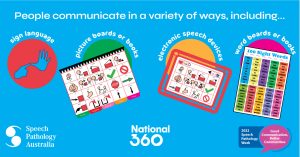AAC Assessment and Intervention – Empowering Communication for Individuals with Speech and Language Challenges
Augmentative and Alternative Communication (AAC) plays a crucial role in empowering individuals with speech and language challenges to express themselves effectively. These therapies are part of speech pathology intervention. For parents and support coordinators, understanding AAC assessment and intervention strategies is essential in optimizing communication outcomes for their loved ones or clients.
To ensure we are fully informed on what AAC is and how it can assist NDIS participants and clients, we will delve into comprehensive evaluation approaches, personalized interventions, and progress monitoring techniques, to provide key insights on how parents and support coordinators can navigate the world of AAC and promote meaningful communication for their NDIS participants, clients, and loved ones.
Let’s explore what Augmentative and Alternative Communication (AAC) is.
What is Augmentative and Alternative Communication (AAC)?
Augmentative and Alternative Communication (AAC) refers to a range of strategies, tools, and techniques that can be used to enhance and support communication for individuals who have difficulty with spoken or written language. These interventions are delivered by an NDIS-registered AAC is designed to assist individuals with various conditions, such as speech and language disorders, developmental disabilities, motor impairments, or injuries that affect communication abilities.
 AAC encompasses a wide range of systems and methods that can be used in combination or individually, depending on the individual’s needs and abilities, and can be categorized into two main types:
AAC encompasses a wide range of systems and methods that can be used in combination or individually, depending on the individual’s needs and abilities, and can be categorized into two main types:
- Augmentative Communication: Augmentative communication refers to any form of communication that supplements or enhances an individual’s existing communication skills. For example, communication boards, picture-based systems, symbol charts, and low-tech communication aids are tools and techniques that can be used. Augmentative communication supports individuals who have partial speech or limited vocabulary to express themselves more effectively.
- Alternative Communication: Alternative communication refers to methods used when an individual has little or no functional speech. It involves using alternative means to communicate, including speech-generating devices (SGDs), text-to-speech software, eye-tracking devices, or specialized computer programs. Alternative communication methods are particularly helpful for individuals with severe speech impairments or those who are unable to produce intelligible speech.
The goal of AAC is to provide individuals with a means to express themselves, interact with others, and fully participate in daily activities. It aims to bridge the communication gap, promote social engagement, support language development, and enhance overall quality of life for individuals who have difficulty with conventional forms of communication.
AAC systems and tools are highly individualized, considering the unique needs, abilities, and preferences of each participant or individual. The selection and implementation of AAC strategies are typically determined through comprehensive assessment, which our highly qualified National 360 Speech Pathology team can complete.
However, it’s important to remember that AAC does not replace the desire or potential for speech development. It instead serves as a temporary or permanent aid to facilitate effective communication for individuals who face challenges in traditional forms of expression.
Why is AAC Assessment important?
AAC assessment is a comprehensive evaluation process that helps identify suitable communication solutions for individuals facing speech and language challenges. It involves assessing communication abilities, needs, and preferences to determine the most effective AAC system or tool. AAC assessment is crucial as it ensures personalized interventions and optimizes communication outcomes for individuals.
It can be broken down into three parts:
- Understanding Communication Challenges – Explaining that the communication difficulties individuals face and the impact on their daily lives.
- Comprehensive Evaluation – Discussing the significance of a thorough AAC assessment to identify strengths, needs, and appropriate AAC solutions.
- Collaborative Approach – Emphasizing the importance of involving a multidisciplinary team, including speech-language pathologists, such as the National 360 Speech Pathology team, educators, and other professionals, in the assessment process.
What are AAC Intervention Strategies?
AAC intervention strategies, such as using communication boards, speech-generating devices, or AAC apps, can greatly benefit individuals with speech difficulties. These strategies provide alternative means of communication, allowing individuals to express themselves, participate in conversations, and engage in daily activities more effectively. AAC interventions support language development, vocabulary expansion, and overall communication skills.
This can be broken down into four parts:
- Person-Centered Approach: Highlighting the significance of tailoring AAC interventions to meet the unique needs and preferences of individuals.
- AAC Systems and Tools: Introducing various AAC systems, such as communication boards, speech-generating devices, and AAC apps, and discussing their benefits in fostering communication.
- Language Development: Exploring the role of AAC in promoting vocabulary expansion, sentence formation, and overall language skills.
- Training and Support: Offering guidance on providing ongoing training and support to individuals using AAC, their families, and support coordinators.
What are ACC Personalized Intervention Plans?
AAC personalised intervention plans are individualised plans that outline specific strategies, goals, and supports for an individual who uses AAC to enhance their communication abilities. These plans are developed based on a comprehensive assessment for the participant’s communication needs, strengths, preferences, and goals.
This can be broken down into three parts:
- Setting Communication Goals: Explaining the importance of setting realistic and meaningful communication goals based on individual abilities and aspirations.
- AAC Implementation Strategies: Discussing strategies for integrating AAC into daily routines, activities, and social interactions to enhance communication effectiveness.
- Communication Partner Training: Providing tips for parents and support coordinators on becoming effective communication partners, including modelling AAC use, providing wait time, and using supportive strategies.
How is ACC Progress Monitoring and Adjustments completed?
AAC progress monitoring and adjustments refer to the process of regularly assessing a participant’s communication progress, analysing the effectiveness of AAC strategies, and making necessary modifications to optimise communication outcomes. It involves tracking the individual’s development, collecting data, and using the information to inform decisions about AAC interventions.
This can be broken down into three parts:
- Tracking Communication Progress: Explaining the significance of monitoring communication outcomes and celebrating achievements.
- Data Collection and Analysis: Discussing methods of collecting data, such as communication logs and video recordings, and analysing progress to make informed decisions.
- Periodic Reviews and Adjustments: Emphasizing the need for regular reviews of AAC intervention plans and adjusting based on evolving needs and goals.
What can parents, carers and loved ones do to support their participant’s AAC assessment and intervention journey at home?
Supporting your participant’s AAC assessment and intervention journey at home is crucial for their progress.
Here are a few tips:
- Familiarize yourself with your child’s AAC system and its features.
- Incorporate AAC into daily routines and activities to encourage consistent practice.
- Model AAC use by demonstrating how to use the system during interactions.
- Provide wait time to allow your child to formulate their responses.
- Seek ongoing training and support from AAC professionals to enhance your skills as a communication partner.
What can parents, carers and loved ones do if their participant shows resistance to using AAC?
Resistance to using AAC can be common, especially during the initial stages. Here’s what you can do:
- Understand and acknowledge their frustrations, and offer support and reassurance.
- Identify and address any underlying concerns or challenges they might be facing.
- Make AAC engaging and fun by incorporating their interests and preferred activities.
- Gradually increase AAC use by starting with short and meaningful interactions.
- Seek guidance from AAC professionals who can provide strategies to overcome resistance and motivate AAC use.
How National 360 can help!
By gaining insights into AAC assessment and intervention strategies, parents, loved ones, carers and support coordinators can play a pivotal role in optimizing communication outcomes for individuals with speech and language challenges. The comprehensive evaluation process, personalized intervention plans, and diligent progress monitoring ensure a person-centered approach to AAC implementation. Engage National 360 Speech Pathologists to assist with AAC assessment and intervention strategies, and let’s empower individuals with AAC, so they can communicate confidently and participate fully in their lives.
Each participant’s AAC assessment and intervention journey is unique, and ongoing collaboration with professionals and continuous learning are key. Contact National 360 and our highly qualified team of Speech Pathologists to engage in our AAC services, so we can help your participant find their voice.
Get in touch with us today!
1300 340 440
For more details on our Speech Pathology services, click here.
Complete our online enquiry form, or referral form.




